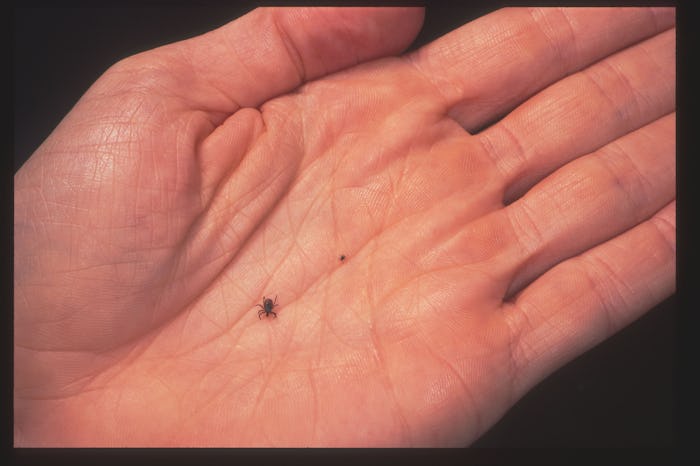In addition to taking common summertime precautions like making sure kids are wearing sunscreen when swimming and helmets when riding bikes, there's a less in-your-face hazard for which parents should be on the lookout: ticks. And one Ohio mom's cautionary tale about her daughter's run-in with the teeniest, tiniest iteration of this backyard health hazard will have you wanting to know what seed ticks are and how to deal with them. After all, vigilance is key when it comes to preventing the long-term issues, such as Lyme disease, these microscopic pests can present.
Beka Setzer of Meigs, Ohio, first shared the story of her 3-year-old daughter Emmalee's encounter with these larval ticks in July of last year in a terrifying Facebook post. When the girl returned inside from playing in the sprinkler, her mom noticed "TINY" black dots all over her body. What happened next might have literally made your skin crawl, if you were in Emmalee's position. Her mom wrote:
Thinking they may have just been seeds, I tried to wipe then scrape one off and it was a TICK! She must've been playing in or near a nest of tick larvae and was covered. I spent nearly an hour and a half picking off well over 150 minuscule baby ticks off of her, gave her a long dawn dish soap bath with repeated washing, washed all bedding, clothing and toys she came into contact with afterwards and administered Benadryl.
Even after her mom's fastidious handling of the situation, Emmalee woke up the next morning with red marks where each of the ticks had attached to her skin, a low-grade fever, and a swollen lymph node. Luckily, the ticks themselves tested negative for the dangerous Lyme disease they can transmit. Emmalee did have to undergo surgery to have a cyst that had formed alongside her swollen lymph node, but is otherwise doing "wonderful," her mother reported — surely a relief.
Still, Emmalee's happy outcome shouldn't be a cue for parents to let down their guards. This past April, Setzer warned on Facebook that she had spotted another tick on her daughter's skin. As she noted in her post, a confluence of factors, including extended warm weather due to climate change, have contributed to the projection that 2017's warmer months will represent one of the worst tick seasons in recent years. So, parents should be sure to take precautions such as using insect repellent on themselves and kids, especially if they'll be in or around wooded areas, and avoiding walking through high grass and leaf litter.
It's also crucial to check skin thoroughly for ticks right away, because time is of the essence: Most ticks can't transmit Lyme disease until they've been attached for 36 to 48 hours, according to the Centers for Disease Control (CDC). Carefully remove them with tweezers if you do spot any on your skin or that of your child.
Seed ticks are so small that people often believe they are a speck of dirt rather than a possible vector of disease, according to CBS News. So, perhaps it was lucky for Emmalee that the ticks can be found in groups of thousands — she had so many ticks on her body that her mom couldn't not notice then and take action.
"Please be cautious and aware!" Setzer concluded her Facebook this year. That really can't be stressed enough, all things considered.
